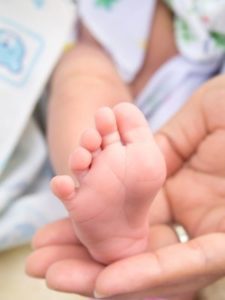Children who are born with a high arch foot face many challenges. Cavus or high arch foot tends to have a c shaped foot. Over time cavus foot can lead to a host of problems from the foot ankle and leg, all the way up to the hip and back. Due to the high arch it causes the foot to be inverted. Inverted feet tend to cause imbalances in the foot, which cause children to walk on the outer aspect of their feet. This foot type can cause chronic ankle sprains because of the way the patient lands while walking. The Achilles tendon, which connects the back of the foot to the heel bone, may be affected as well. Another common pediatric problem is in-toeing, or the toes pointing towards the inside of the foot. There are some patients that develop tendonitis on top of the foot or on the outer aspect of the foot which are all caused by the rotation of the foot. Some patients develop pain on the bottom pads of their feet called metatarsalgia. This is caused by the rotation or downward rotation of the long bones of the foot called metatarsals. There is a natural fat pad we are born with, which deteriorates because of how far down the heads of the bones are. Other parts of the body besides the ankle and foot are affected; the knee can be rotated out, causing strain on the knee, hip and back.
 When a child begins to walk, parents should note what their feet look like and how they are walking. If you notice they are walking on the outside of their foot and suspect a high arch foot we recommend you seek a podiatrist. A foot specialist who treats children regularly in their practice can notice problems in structure, the way they walk.
When a child begins to walk, parents should note what their feet look like and how they are walking. If you notice they are walking on the outside of their foot and suspect a high arch foot we recommend you seek a podiatrist. A foot specialist who treats children regularly in their practice can notice problems in structure, the way they walk.
These foot problems can be noticed in newborns. If deformities are seen one and appear severe, which is rare, some patients are put in casts to change the actual shape of the foot. Another way of way of treating a high arch foot is through orthotics put in the shoes that change the way the foot is positioned. As the child begins to walk the best way to treat a high arch is with a custom orthotic. A custom orthotic will support the foot correctly and decrease pressure on the different parts of the foot. You decrease the possibility of spraining your ankle and the foot is put in a position where it can act in a more stable position.
Patients with this foot type should be evaluated regularly, especially with children to make sure the orthotic fits the foot correctly and is doing it’s job. The other part of using orthotics in a child is for the podiatrist to evaluate shoe gear to make sure the orthotic fits and is supported correctly. If the problem is severe enough there are surgical procedures that a foot specialist can determine to be necessary. Some procedures used for cavus or high arch foot is an actual cut in the heel bone to change the angle of the heel bone. There are also implants used to change the ankle joints position. As always surgery is a last option.
If you notice this type of deformity; c shaped foot- the first thing that should run through your mind is the thought that this type of deformity can lead to a multitude of physical problems for your child as they grow into adulthood. Please consider a podiatrist for an evaluation.
